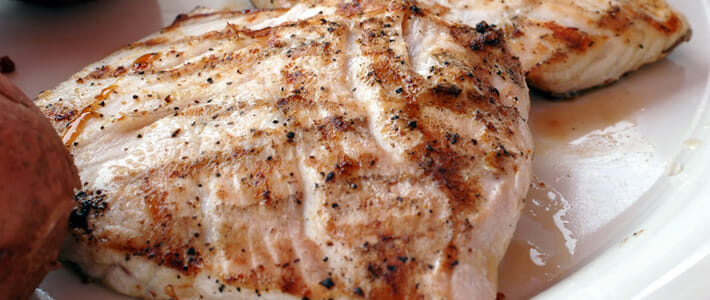Amberjack
Refers to 3 species of Atlantic fish. Each have characteristics that set them apart from each other

Greater amberjacks are the largest of the jacks. They usually have dark stripes extending from nose to in front of their dorsal fins. They have no scutes and soft dorsal bases less than twice the length of the anal fin bases. They are usually 18 kg (40 pounds) or less, and are found associated with rocky reefs, debris, and wrecks, typically in 20 to 75 m (10 to 40 fathoms).
Lesser amberjacks have a proportionately larger eye and deeper body than the greater amberjack. They are olive green or brownish-black with silver sides and usually have a dark band extending upward from their eyes. The adults are usually less than 5 kg (10 lbs).
Banded Rudderfish is the second smallest Amberjack. This jack can be distinguished from the Pilotfish by the presence of a first dorsal fin. Large ones, with a raccoon-stripe on the eye and an iridescent gold stripe on the side, are usually called Amberjacks when caught, and juveniles are called Pilotfish. They are found as far north as Nova Scotia.
Product pdf for download-
4 oz (114g) raw edible portion
-
Calories 120
-
Calories from Fat 20
-
Total Fat 2g
-
Saturated Fat 0g
-
Cholesterol 50mg
-
Sodium 40mg
-
Total Carbohydrates 0g
-
Protein 24g
Texture
Firm texture
Quality Control
Alligator meat can be frozen for up to a year if all the fat and tendons are removed.
Preparation
Poaching, steaming, baking, broiling, sautéing, and microwaving are excellent low-fat cooking methods.
Interesting Fact
Amberjacks are voracious predators that feed on squid, fish, and crustaceans and are thought to spawn offshore throughout most of the year.
Alternatives
Mahi-mahi, yellowtail, and hamachi
Source
AJ is found in the Mediterranean, the Caribbean, the eastern seaboard of both North and South America, and in some parts of the Indo-Pacific. Amberjack are also found throughout Florida around natural or man-made reefs, rock outcrops, and wrecks.
Harvest Method
AJ is caught by commercial fishermen using longlines.
Quality Control
Fresh whole fish should have a shiny surface with tightly adhering scales, gills that are deep red or pink, free of slime, mucus, and off-odor, a clean, shiny belly cavity with no cuts or protruding bones, and a mild aroma similar to the ocean.
Fresh steaks, fillets, and loins should have a translucent look, flesh that is firm and not separating, a mild odor similar to the ocean, and packaging that keeps them from being bent in an unnatural position.
Flavor
White meat with mild flavor; extra lean fish.
Market Segments
This fish is appropriate for casual dining, fine dining, hotels, and resort/club of the market.